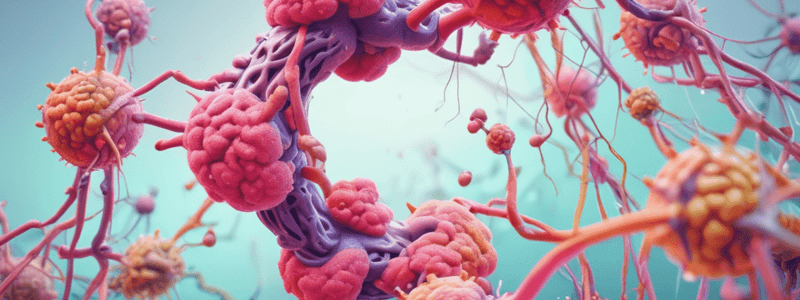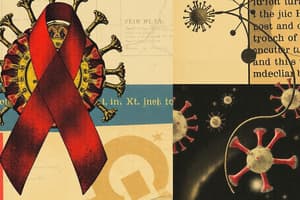Podcast
Questions and Answers
What is the role of the viral envelope in an HIV particle?
What is the role of the viral envelope in an HIV particle?
- Forms the dense core of the virus
- Protects the viral RNA from degradation
- Contains the viral protein p24
- Facilitates recognition and binding to host cell receptor CD4 (correct)
Which protein does NOT play an essential role in HIV entry into the host cell?
Which protein does NOT play an essential role in HIV entry into the host cell?
- GP20 (correct)
- GP120
- GP41
- All of these do
Which of these proteins is the transmembrane envelope glycoprotein?
Which of these proteins is the transmembrane envelope glycoprotein?
- GP120
- GP65
- GP10
- GP41 (correct)
Which HIV Drug class stops HIV from being integrated into the cell's DNA?
Which HIV Drug class stops HIV from being integrated into the cell's DNA?
Which HIV drug class stops HIV changing from a single strand of RNA to a double strand of DNA?
Which HIV drug class stops HIV changing from a single strand of RNA to a double strand of DNA?
At What HIV viral load is a patient undetactable and untransmittable?
At What HIV viral load is a patient undetactable and untransmittable?
What is the primary goal of HIV treatment?
What is the primary goal of HIV treatment?
Which of the following is NOT a key step in the HIV entry process?
Which of the following is NOT a key step in the HIV entry process?
What is the recommended approach for achieving viral suppression in HIV treatment?
What is the recommended approach for achieving viral suppression in HIV treatment?
Which of the following drug classes is typically used as an anchor in HIV treatment regimens?
Which of the following drug classes is typically used as an anchor in HIV treatment regimens?
Which of the following is NOT a goal of HIV treatment?
Which of the following is NOT a goal of HIV treatment?
What determines the type of CD4 cell that HIV can infect, known as the virus tropism?
What determines the type of CD4 cell that HIV can infect, known as the virus tropism?
What is the mechanism used by entry inhibitors to prevent HIV-1 cellular entry?
What is the mechanism used by entry inhibitors to prevent HIV-1 cellular entry?
Which HIV entry inhibitor belongs to the attachment inhibitors subclass?
Which HIV entry inhibitor belongs to the attachment inhibitors subclass?
When are entry inhibitors typically indicated for use in HIV treatment?
When are entry inhibitors typically indicated for use in HIV treatment?
What is the brand name of Fostemavir?
What is the brand name of Fostemavir?
What is the generic name of Selzentry?
What is the generic name of Selzentry?
What is the mechanism of action of Fostemsavir in the treatment of HIV?
What is the mechanism of action of Fostemsavir in the treatment of HIV?
Which enzyme should be considered when administering Fostemsavir due to potential interactions?
Which enzyme should be considered when administering Fostemsavir due to potential interactions?
What is the unique aspect of Selzentry (Maraviroc) among HIV medications?
What is the unique aspect of Selzentry (Maraviroc) among HIV medications?
What is the primary target of Maraviroc (Selzentry) in the HIV entry process?
What is the primary target of Maraviroc (Selzentry) in the HIV entry process?
T/F: Maraviroc is used in combination antiretroviral treatment in HIV patients with only CCR5-tropic HIV1.
T/F: Maraviroc is used in combination antiretroviral treatment in HIV patients with only CCR5-tropic HIV1.
What is the mechanism of action of ibalizumab-uiyk (TROGARZO) in treating HIV-1 infection?
What is the mechanism of action of ibalizumab-uiyk (TROGARZO) in treating HIV-1 infection?
Which step of the HIV life cycle does reverse transcriptase catalyze?
Which step of the HIV life cycle does reverse transcriptase catalyze?
Which class of HIV medications is ibalizumab-uiyk (TROGARZO) classified under?
Which class of HIV medications is ibalizumab-uiyk (TROGARZO) classified under?
What is the primary indication for the use of ibalizumab-uiyk (TROGARZO)?
What is the primary indication for the use of ibalizumab-uiyk (TROGARZO)?
How is ibalizumab-uiyk (TROGARZO) administered?
How is ibalizumab-uiyk (TROGARZO) administered?
Which class of HIV reverse transcriptase inhibitors acts as chain terminators?
Which class of HIV reverse transcriptase inhibitors acts as chain terminators?
Which is NOT true about NRTIs?
Which is NOT true about NRTIs?
T/F: TDF-containing regimens can have improved renal and bone safety compared with TAF-containing regimens.
T/F: TDF-containing regimens can have improved renal and bone safety compared with TAF-containing regimens.
Which of the following statements about the mechanism of action of NNRTIs is CORRECT?
Which of the following statements about the mechanism of action of NNRTIs is CORRECT?
Which of the following is NOT true about Efavirenz?
Which of the following is NOT true about Efavirenz?
Which of the following is a key advantage of doravirine (PIFELTRO) compared to efavirenz (SUSTIVA)?
Which of the following is a key advantage of doravirine (PIFELTRO) compared to efavirenz (SUSTIVA)?
Which of the following is a common adverse effect associated with all NNRTIs?
Which of the following is a common adverse effect associated with all NNRTIs?
Which NRTI has an increased risk of hypersensitivity reactions in patients with the HLA-B*57:01 allele?
Which NRTI has an increased risk of hypersensitivity reactions in patients with the HLA-B*57:01 allele?
Which HIV drug class ends in -tegravir?
Which HIV drug class ends in -tegravir?
Which of the following is a common adverse effect associated with HIV protease inhibitors?
Which of the following is a common adverse effect associated with HIV protease inhibitors?
T/F: elvitegravir and raltegravir are recommened as first line therapy for HIV patients
T/F: elvitegravir and raltegravir are recommened as first line therapy for HIV patients
Which is true about HIV Integrase Strand
Transfer Inhibitors?
Which is true about HIV Integrase Strand Transfer Inhibitors?
Which is true about HIV protease inhibitors?
Which is true about HIV protease inhibitors?
Which of the following statements about cobicistat is true?
Which of the following statements about cobicistat is true?
Flashcards are hidden until you start studying
Study Notes
HIV Structure and Infection
Overview of HIV Structure
Human Immunodeficiency Virus (HIV) is composed of various proteins and genetic material enclosed within a protective shell called a viral particle, or virion. The main components of an HIV particle include:
-
Viral Envelope (VE): A thin lipid membrane derived from the host cell's plasma membrane during budding. The VE contains transmembrane proteins such as GP120 and GP41.
-
Capsid: A dense core consisting of the viral protein CA (capsid antigen) formed by self-assembly of CA monomers. Within the capsid lies the viral genome (RNA).
-
Nucleocapsid: The complex between the RNA genome and the viral protein p24 (also known as regulatory protein p24 or Gag polyprotein p24).
-
Surface Spikes: On the outermost layer of the viral particle, surface spikes protrude from the envelope, which facilitate recognition and binding to host cell receptor CD4. The spikes are primarily made up of non-glycosylated parts of the GP120 protein, specifically the variable regions with constant domains.
Mechanism of HIV Entry into Cells
The process by which HIV enters a host cell involves several steps:
-
Binding: HIV uses its external spike proteins, particularly GP120, to attach itself to the CD4 protein on the surface of the host T-cell.
-
Fusion: After the virus successfully binds to its target cell, it undergoes fusion. The VE merges with the cell membrane, releasing the viral contents into the infected cell.
Infection Cycle
Once inside the host cell, the viral RNA replicates, leading to production of more HIV particles. These newly assembled particles are released from the host cell, initiating the infection cycle once again. The entire lifecycle of an HIV-infected cell involves a balance between viral replication and host defense mechanisms, leading either to the death of the infected cell or the establishment of chronic infection.
Conclusion
Understanding the structure and infection cycle of HIV is crucial for developing novel treatments and vaccines against the virus. Researchers continue to study the details of these processes, aiming to create more effective strategies for preventing and treating HIV infections.
Studying That Suits You
Use AI to generate personalized quizzes and flashcards to suit your learning preferences.




